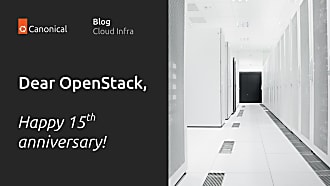Tytus Kurek
on 27 February 2023
VMware alternatives: discover open source
Are you looking for VMware alternatives?
Think open source – the world’s leading software portfolio. Open-source software enables you to build fully functional virtualisation and cloud infrastructure while ensuring total cost of ownership (TCO) reduction and business continuity. In this blog, we will walk you through the open source ecosystem. We will help you understand how it differs from other VMware alternatives by answering five common questions.
What is open source?
Open source is a generic term for any software released under a licence that allows its unlimited redistribution and modification. It is available for everyone, people can use it free of charge, and everyone can contribute to its development. Unlike VMware software or its proprietary alternatives, there is no single entity that owns open source. Instead, it is usually created under the governance of independent foundations. Those associate individuals, universities, research institutions and large enterprises from various parts of the world.
So you can think of open source as a collection of software meeting those criteria. There is no single place where this “collection” is hosted, however. Open-source software is distributed across numerous code repositories on GitHub, SourceForge, Launchpad, etc. Fortunately, leading Linux distributions provide streamlined access to this software. By making applications and infrastructure components available in the form of software packages, they serve as open source integration platforms.

Ubuntu, published by Canonical, is the world’s leading open source integration platform Preferred by 66% of developers and endorsed by executives, Ubuntu powers one-third of all Linux-based web servers worldwide and its market share in the infrastructure space constantly increases. Ubuntu provides immediate access to tens of thousands of software packages and ensures a human-friendly interface to install and use open source.
Why open source over other VMware alternatives?
So obviously, open-source solutions are just one of the available VMware alternatives. Several proprietary solutions exist too. These include leading public clouds, premium versions of Proxmox Virtual Environment (VE), Citrix Hypervisor, Hyper-V, etc. What makes open source better, then?
In short, the benefits of open source can be summarised in the following five bullet points:
- TCO reduction – since open-source software does not require attaching any expensive licences, standardising on open source leads to significant cost savings over time.
- No vendor lock-in – with open source, you are no longer dependent on a single vendor; the software is developed by the entire community, consisting of thousands of developers.
- Innovation advances – the development pace of open-source software is way higher than for proprietary software companies, which helps you to stay at the forefront of the technology.
- Higher software quality – open-source software usually passes through a rigorous software development process which results in higher quality and better security.
- Community collaboration – since billions of people worldwide use open source daily, enterprises can benefit from fantastic community collaboration through numerous industry conferences, technical forums, knowledge bases, etc.
No wonder open source is becoming the new standard. And this trend will only intensify in the following years.

Is open source suitable for enterprises?
Yes, it is. There is no reason why it wouldn’t be. All of the benefits mentioned above speak in favour of open source.
However, enterprises need not just software but all types of commercial services around it. For example, companies might not have enough time to experiment with the software. They would rather hire external consultants to deploy IT systems for them so that they could start using them immediately. Or they cannot rely solely on community support if their business applications are expected to run 24/7.
Canonical understands those challenges and provides a complete package of optional commercial services for businesses willing to adopt open source on Ubuntu. This includes design and delivery services for open-source solutions, enterprise support, fully-managed services for both infrastructure and application, and comprehensive training courses. By partnering with Canonical, enterprises can rest assured that their migration to open source will be hassle-free and stressless.
Telcos, big banks, government institutions and leading companies in the industrial space are all examples of organisations that have successfully completed their digital transformation with open source. There is no reason why your company shouldn’t join this club.

How to build a cloud with open source?
Unlike VMware or its proprietary alternatives, there is no single open-source monolith that provides all the capabilities in a single place. Instead, several independent components exist that, added together, can serve as a cloud.
Think of it through an analogy to Lego. Let’s say that you want to build a car with Lego. There are many pieces in the box. Each piece doesn’t look like a car. However, when you start mounting them together, you will quickly see an engine, wheels, seats, etc. And even more importantly, you can choose to build a Coupe, Sedan, SUV or even a track! A car that you designed according to your needs.
The same applies when building cloud infrastructure with open source. By using various independent software components, you can build a simple virtualisation environment, an ordinary Infrastructure-as-a-Service (IaaS) cloud, a Container-as-a-Service (CaaS) cloud or even a Software-as-a-Service (SaaS) platform. Then you can extend its functionality with live migration capabilities, automated power management, observability, etc. to ensure feature parity with your existing VMware infrastructure.

How to move to open source?
Preferably by a trusted partner. Canonical provides free access to all necessary open-source components that will help you to build cloud infrastructure tailored to your needs. Moreover, the most demanding organisations can leverage Canonical’s professional services, which include analysis of existing workloads, designing the right migration strategy to avoid service downtimes and ensure business continuity, etc.
The migration away from VMware is not a trivial task. No one claims it is. However, by choosing open source over other VMware alternatives and by standardising on the right open source integration platform, you can be assured that your migration is not only going to be painless but also that your organisation will see long-term benefits, such as increased innovation and TCO reduction.

Explore migration strategies:
Further Reading
Learn more about Canonical’s open source infrastructure solutions.



